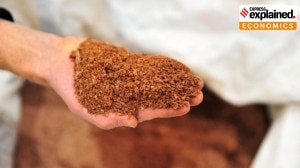Surgical cotton gets a boost
Central Institute for Cotton Research,Nagpur,is looking at partnering with farmers and absorbent cotton manufacturers to promote organic desi cotton as raw material
Surgical cotton or absorbent cotton is in great demand all over the world,but with desi cotton considered ideal raw material for it being edged out,manufacturers have been banking heavily on regular American cotton.
The Central Institute for Cotton Research (CICR) here is now working towards partnering with farmers and absorbent cotton manufacturers for promoting organic desi cotton as raw material.
The CICR has already started producing desi cotton seeds to be distributed to a select group of farmers who are going to have assured buyers offering good price.
We have discussed it with many manufacturers. They are ready to pay up to Rs 4,000 per quintal. For now,we will emphasise on the idea in Vidarbha and parts of Madhya Pradesh where farmers around villages near surgical cotton units will be encouraged to produce organic desi varieties with an assured high price, said CICR director Keshav Kranthi.
One such unit has come up recently near Nagpur.
Prakash Rathi,owner of Rathi Chemicals,is partnering in the venture with CICR. The Central Institute for Research in Cotton Technology (CIRCOT),Mumbai,will be another stakeholder in the process of converting raw cotton into finished product.
As of now,the companies in India are using Bengal Cotton,a desi variety being produced mainly in north-east and Rajasthan,to manufacture surgical cotton. But it requires chemical treatment. What we are looking at is having organic desi varieties that will eliminate the need for chemical treatment. We have certain microbes that can be used, Kranthi said.
Another advantage with desi cotton is its low input cost. It requires less inputs since it has traditionally come to withstand hard Indian conditions, Kranthi said.
He says because organic cotton is devoid of chemicals,it is ideally the most-suited cotton for manufacturing absorbent cotton. And anything organic has a great demand in Europe,so the produce will also have a great export potential, he adds.
During the next planting season,CICR is planning to have 500 hectares of dedicated desi organic area in Vidarbha.
In India itself,the demand for surgical cotton is up to 20 lakh bales per year,Kranthi adds.
Till about 7-8 years ago,India had about 20 lakh hectares of desi cotton area. Now,it has been reduced to just about 1 lakh hectare, Kranthi said.
Desi varieties have been grown in India for centuries and had come to stay as most sturdy varieties till they were slowly replaced by American cotton and now by Bt cotton. Desi varieties,with short-staple fibre,which can be grown with organic inputs,are considered ideal for manufacturing absorbent cotton.
Ideally,surgical cotton requires coarse textured lint with a fibre length of approximately 18 mm so that these can easily be arranged into layers for surgical use. Micronaire is an index of fineness or coarseness of the fibre and the preferred micronaire value for surgical use is 6.5 to 8.0.
CICR has a rich repository of desi cotton that will be utilised for popularising this type of cotton. Several varieties like Lohit,LD-133,RG-8,LD-327,DS-21,LD-491,HD-11 have been released by the public sector in the past with fibre quality parameters suitable for surgical cotton, Kranthi said.





- 01
- 02
- 03
- 04
- 05


























